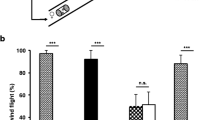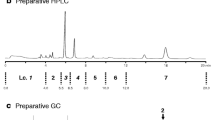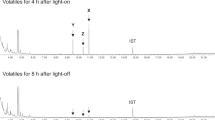Abstract
The sex pheromone of the mealybug, Planococcus minor was isolated by fractionation of crude pheromone extract obtained by aeration of virgin females. The pheromone was identified as the irregular terpenoid, 2-isopropyl-5-methyl-2,4-hexadienyl acetate, by mass spectrometry, microchemical tests, and 1H NMR spectroscopy. The stereochemistry of the pheromone was assigned as (E) by comparison with synthetic standards of known geometry. The compound was highly attractive to males in laboratory bioassays, whereas the (Z)-isomer appeared to antagonize attraction.






Similar content being viewed by others
References
Arai, T. 2000. The existence of sex pheromone of Pseudococcus cryptus Hempel (Homoptera: Pseudococcidae) and a simple bioassay. Appl. Entomol. Zool. 35:525–528.
Arai, T., Sugie, H., Hiradate, S., Kuwahara, S., Itagaki, N., and Nakahata, T. 2003. Identification of a sex pheromone component of Pseudococcus cryptus. J. Chem. Ecol. 29:2213–2223.
Armesto, D., Gallego, M. G., Horspool, W. M., and Agarrabeitia, A. R. 1995. A new photochemical synthesis of cyclopropanecarboxylic acids present in pyrethroids by the aza-di-π-methane rearrangement. Tetrahedron 51:9223–9240.
Bierl-Leonhardt, B. A., Moreno, D. S., Schwarz, M., Fargerlund, J., and Plimmer, J. R. 1981. Isolation, identification and synthesis of the sex pheromone of the citrus mealybug, Planococcus citri (Risso). Tetrahedron Lett. 22:389–392.
Biswas, J. and Ghosh, A. B. 2000. Biology of the mealybug, Planococcus minor (Maskell) on various host plants. Environ. Ecol. 18:929–932.
Hinkens, D. M., MCelfresh, J. S., and Millar, J. G. 2001. Identification and synthesis of the sex pheromone of the vine mealybug, Planococcus ficus. Tetrahedron Lett. 42:1619–1621.
Hwang, J. S., and Chu, Y. I. 1987. A bioassay method of the sex pheromone of the citrus mealybug, Planococcus citri (Risso). Plant Prot. Bull. (Taiwan, R. O. C.) 29:307–319 (in Chinese).
Millar, J. G., Daane, S. L., MCelfresh, J. S., Moreira, J. A., Maraka-kuenen, R., Guillen, M., and Bentley, W. J. 2002. Development and optimization of methods for using sex pheromone for monitoring the mealybug Planococcus ficus (Homoptera: Psudococcidae) in California vineyards. J. Econ. Entomol. 95:706–714.
Millar, J. G., Midland, S. L., MCelfresh, J. S., and Daane, K. 2005. (2,3,4,4-tetramethylcyclopentyl)methyl acetate, a sex pheromone from the obscure mealybug: first example of a new structural class of monoterpenes. J. Chem. Ecol. 31:2999–3005.
Moreno, D. S., Fargerlund, J., and Ewart, W. H. 1984. Citrus mealybug (Homoptera: Pseudococcidae): Behavior of males in response to sex pheromone in laboratory and field. Ann. Entomol. Soc. Am. 77:32–38.
Negishi, T., Ishiwatari, T., and Asano, S. 1980. Sex pheromone of the Comstock mealybug, Pseudococcus comstocki Kuwana: Bioassay method, male response-habits to the sex pheromone. Jpn. J. Appl. Entomol. Zool. 24:1–5.
Takano, D., Nagamitsu, T., Ui, H., Shiomi, K., Yamaguchi, Y., Masuma, R., Kuwajima, I., and Omura, S. 2001. Total synthesis of nafuredin, a selective NADH-fumarate reductase inhibitor. Org. Lett. 3:2289–2291.
Tashiro, H., Chambers, D. L., Moreno, D., and Beavers, J. 1969. Reproduction in the California red scale, Aonidiella aurantii. III. Development of an olfactometer for bioassay of the female sex pheromone. Ann. Entomol. Soc. Am. 62:935–940.
Tu, W. G., Wu, W. J., and Lee, P. P. 1988. Planococcini of Taiwan (Homoptera: Pseudococcidae). Ann. Taiwan Mus. 31:71–101 (in Chinese).
USDA. 2000. ScaleNet. Agricultural Research Service. http://www.sel.barc.usda.gov/scalenet/scalenet.htm.
Venette, R. C. and Davis, E. E. 2004. Mini risk assessment, passionvine mealybug: Planococcus minor (Maskell) (Pseudococcidae: Hemiptera). National Cooperative Agricultural Pest Survey (CAPS) Target Pests CAPS PRA: Planococcus minor. http://www.aphis.usda.gov/ppq/ep/pestdetection/pra/pminorpra.pdf.
Walton, V. M., Daane, K. M., Walter, J., Bentley, W. J., Millar, J. G., Larsen, T. E., and Malakar-Kuenen, R. 2006. Pheromone-based mating disruption of Planococcus ficus (Hemiptera: Pseudococcidae) in California Vineyards. J. Econ. Entomol. 99:1280–1290.
Acknowledgment
The authors thank Penny Gullan of the University of California, Davis for preliminary identification of the species and Doug Miller and his colleagues at the US Department of Agriculture in Beltsville, Maryland, USA for confirming the species identity. The authors thank Jocelyn Millar of the University of California, Riverside for suggestions on the synthesis of the pheromones.
Author information
Authors and Affiliations
Corresponding author
Rights and permissions
About this article
Cite this article
Ho, HY., Hung, CC., Chuang, TH. et al. Identification and Synthesis of the Sex Pheromone of the Passionvine Mealybug, Planococcus minor (Maskell). J Chem Ecol 33, 1986–1996 (2007). https://doi.org/10.1007/s10886-007-9361-7
Received:
Revised:
Accepted:
Published:
Issue Date:
DOI: https://doi.org/10.1007/s10886-007-9361-7




